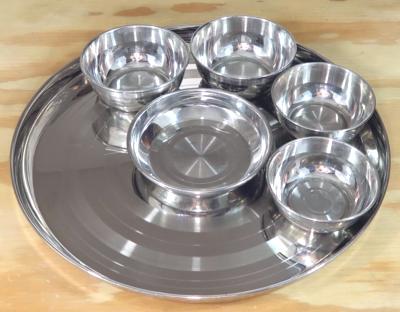 Thali (lit. plate) and Katori (lit. bowl), as shown in the photo, are the main
items used in for a formal place setting in South Asia, particularly India,
but also surrounding regions, and in parts of Southeast Asia and the
Caribbean.
Thali (lit. plate) and Katori (lit. bowl), as shown in the photo, are the main
items used in for a formal place setting in South Asia, particularly India,
but also surrounding regions, and in parts of Southeast Asia and the
Caribbean.
The center of the rimmed Thali is usually occupied by rice or a stack of flat bread, with Katori placed around. In some communities, the arrangement and what is in the Katori can be quite structured. Thali come in various sizes, and in much of India, women were always served with a smaller Thali then men. Traditionally, these items were made of brass, copper or silver, but today stainless steel is most common.
Each person served has a thali, and once food is placed on a thali it is dedicated to that person, and none may be offered to others, or taken by others - except a mother may give bits from her thali to a babe in arms.
For informal meals and and children's servings, there are various stainless steel Thali pressed with separate chambers, similar to a TV Dinner tray. Often there is one large chamber for rice or bread, and three smaller ones, but some have only two smaller chambers, and there are larger ones with one large, one medium, and three smaller chambers.
For large events, the Thali may be a length of Banana Leaf, and the metal katori replaced by disposable clay ones (traditional). Today many varieties of paper katori may be used. Some are covered in foil to imitate metal, and some advertize being 100% recycled materials and biodegradable.
To increase the possibility of confusion, the word "Thali" today is also used for a whole meal set out on a Thali. Less confusing is Bhojanam (lit. whole meal) but that term is not as well known.
Fancier Thalis are decorated with flowers, candles, offerings of sweets, water and other devotional items. These are prepared as ceremonial Puja offerings. Puja means reverence, honor, homage, adoration or worship in Sanskrit. Puja may be offered to Divinities, or to honored persons, alive or departed.
More on South Asian Serving Pieces